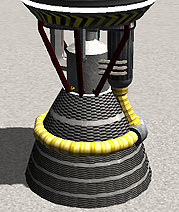Reaction engine
A rocket engine is an engine that uses nothing but its onboard propellant to generate thrust. Unlike traditional air breathing engines used by atmospheric crafts rocket engines are able to function in a vacuum where no oxygen is present.
Contents
[hide]History
Rocket engines were present in KSP in all public releases of the game.
Approaches to rocket engines
Rocket engines come in two commonly used forms. The first and most ancient type is a solid fuel rocket which is as simple as igniting a solid, self-oxidizing compound or mixture within the casing of the rocket and allowing the escaping gases to be released through a nozzle at the rear. There are currently two booster rocket sizes included.
Liquid fuel engines are powered by a liquid propellant which is comprised of combustible liquid fuel and oxidizer. In the real world typical liquid fuels are often liquid hydrogen or kerosene, and typical oxidizers are liquid oxygen or nitrous-oxide. All engines use Bell nozzles except the only aerospike engine.
Solid fuel rocket engines
Advantages
- Have a very high thrust to weight ratio.
- Engine and fuel tank are combined in one part, lowering part count, simplifying design and improving stability.
Disadvantages
- Monolithic design, must be built in one piece.
- Cannot be throttled or switched off after ignition.
- Once spent, they are unable to use fuel from another source of the craft.
Liquid fuel rocket engines
Advantages
- Modular design: fuel and other components can be stored elsewhere in the craft.
- Throttle can be adjusted depending on thrust requirements.
- Can be switched off and re-ignited at will.
- Many nozzles can be gimballed for thrust vectoring.
- Efficiency largely dependent on design, with large variations. For early stages, high-output engines with low fuel-efficiency can be used to reach a low Kerbin orbit, while extremely efficient but low-power engines should be used for travelling between planets and moons to save fuel and extend the range of the craft.
Disadvantages
- Lower power to weight ratio compared to solid rocket engines.
- Complex design with fuel tanks and other additional components.
- More points of possible failure such as if the parts tear apart from stress.
| ||||||||||||||||||||||||||||||||||||||||||||||||||||||||||||||||||||||||||||||||||
















